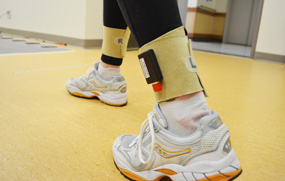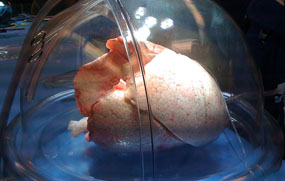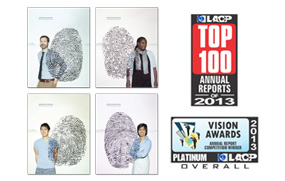 As UHN's monthly research newsletter, NRx reports on the full spectrum of leading research from UHN's five research institutes: the Princess Margaret (PM) Cancer Centre, the Toronto General Research Institute (TGRI), the Toronto Western Research Institute (TWRI), the Toronto Rehabilitation Institute (TRI) and the Techna Institute (Techna).
As UHN's monthly research newsletter, NRx reports on the full spectrum of leading research from UHN's five research institutes: the Princess Margaret (PM) Cancer Centre, the Toronto General Research Institute (TGRI), the Toronto Western Research Institute (TWRI), the Toronto Rehabilitation Institute (TRI) and the Techna Institute (Techna).
In this issue you can read about:
- How feedback on walking activity influences stroke recovery
- Measuring the risk of blood clots in patients with cancer
- A new method for identifying the best donor lungs
- How folds in DNA influence gene expression
- The benefits of palliative care in patients with advanced cancer
- UHN's award winning research report
We hope that you find NRx informative. If you have feedback or questions, please contact www@uhnresearch.ca.
Christopher J. Paige, PhD, FCAHS
Vice President, Research
University Health Network

Accelerometers worn on the ankles can provide information about daily walking activity.
Personalized feedback within rehabilitation programs is important for achieving goals because it enables people to adjust their behaviours, gauge their progress and stay motivated. For those recovering from a stroke, the most common goal is to improve walking ability. While affordable technologies exist that could provide detailed feedback, rehabilitation programs do not currently take advantage of them.
TRI Scientist Dr. Avril Mansfield tested whether the use one of these technologies—a motion sensing technology known as an accelerometer—could enhance rehabilitation programs for those recovering from a stroke.
A selection of participants wore accelerometers on each ankle for up to 12 hours a day while they were enrolled in the program. The information recorded by the accelerometer was compiled and shared with participants by their physiotherapist in the form of daily walking activity reports and incorporated into standard goal setting approaches.
The research team found that patients' walking speeds and consistency of step speed improved when they received the added feedback. Dr. Mansfield comments, “These results are encouraging because gains in walking speed enable patients to better carry out daily tasks. Also, the more consistent steps taken by patients within the study group may indicate enhanced walking stability. Taken together, integrating this type of personalized feedback into rehabilitation may to help speed up recovery and lead to better quality of life.”
This work was supported by the Ontario Ministry of Health and Long-Term Care, the Ontario Stroke Network, the Canada Foundation for Innovation, the Ontario Innovation Trust, the Ministry of Research and Innovation, and the Toronto Rehab Foundation.
Use of accelerometer-based feedback of walking activity for appraising progress with walking-related goals in inpatient stroke rehabilitation: a randomized controlled trial. Mansfield A, Wong JS, Bryce J, Brunton K, Inness EL, Knorr S, Jones S, Taati B, McIlroy WE. Neurorehabilitation and Neural Repair. 2015 Jan 20. [Pubmed abstract]

Chemotherapeutic agents such as cisplatin increase a patient's risk of developing deadly blood clots.
Patients who develop cancers that arise from reproductive cells—known as germ cell tumours (GCTs)—are at an increased risk of developing blood clots in their veins after they receive chemotherapy. As a result they are more likely to develop medical complications that could lead to hospitalization or death.
While treatment guidelines suggest that patients with cancers can be treated with blood thinners to reduce the risk of blood clots, there is insufficient data available to support the use of this treatment in patients with GCTs. Furthermore, there is currently no way to identify patients with GCTs who are at the highest risk of developing blood clots.
To address this problem Dr. Philippe Bedard and collaborators asked whether the size of secondary cancers that spread from GCTs to the lymph nodes could accurately predict blood clot risk. Results from their analysis of over 200 patients with GCT undergoing chemotherapy showed that patients with large lymph node cancers (> 5cm in diameter) were more susceptible to blood clots.
“Using the size of the cancerous lymph node to identify patients who are disproportionately at risk of developing blood clots is extremely appealing because this information is readily available from routine imaging scans taken when a patient is diagnosed,” explains Dr. Bedard. “We’ve already incorporated this into treatment plans at PM.”
Large retroperitoneal lymphadenopathy as a predictor of venous thromboembolism in patients with disseminated germ cell tumors treated with chemotherapy. Srikanthan A, Tran B, Beausoleil M, Jewett MA, Hamilton RJ, Sturgeon JF, O'Malley M, Anson-Cartwright L, Chung PW, Warde PR, Winquist E, Moore MJ, Amir E, Bedard PL. Journal of Clinical Oncology. 2015 January 20. [Pubmed abstract]

During ex vivo lung perfusion, the lungs' blood vessels are flushed with a solution containing complex sugars, an antibiotic and a medication to block inflammation.
For people with severe lung disease, a lung transplant can be a life-saving treatment. Unfortunately, not all patients who need a new pair of lungs will receive them: the demand for healthy lungs far exceeds availability.
To increase the number of lungs suitable for transplantation, TGRI Senior Scientist Dr. Shaf Keshavjee and his team developed a new technique that better preserves the lung during its transit from the donor to recipient. The technique —known as ex vivo lung perfusion—involves storing the donor lung in conditions that mimic the body: the lungs are ventilated, maintained at normal body temperature and a fluid is circulated through the lung’s blood vessels (follow this link to watch a video of the ex vivo lung perfusion technique).
Recently, Dr. Keshavjee’s team demonstrated that a detailed examination of the fluid circulated through the lung could reveal which lungs may be less suitable candidates for transplantation. After four hours in the ex vivo system, researchers detected high levels of two proteins—interleukin-8 and growth-regulated oncogene-α—in the fluid of lungs that performed poorly after transplantation.
“We hope that measuring the levels of these proteins during ex vivo lung perfusion will allow clinicians to safely expand the current donor pool and improve outcomes after lung transplantation” says Dr. Keshavjee.
This work was supported by the Canadian Institutes of Health Research and the Toronto General & Western Hospital Foundation. M Cypel holds a Tier 2 Canada Research Chair in Lung Transplantation.
Protein expression profiling predicts graft performance in clinical ex vivo lung perfusion. Machuca TN, Cypel M, Yeung JC, Bonato R, Zamel R, Chen M, Azad S, Hsin MK, Saito T, Guan Z, Waddell TK, Liu M, Keshavjee S. Annals of Surgery. 2015 March. [Pubmed abstract]

How DNA is folded influences gene expression—a process akin to the art of origami where different folding gives rise to different objects.
A heart muscle cell functions differently from a bone cell or a cancerous cell, yet inside each is an identical set of DNA arranged into genes. What makes one cell type different from another is the unique profile of genes that are turned on ('expressed') or off at any given moment. While the control of gene expression is one of the key gatekeepers to the specialization of normal cells, little is known about how the three-dimensional organization of DNA affects this complex process.
PM Cancer Centre Scientist Dr. Mathieu Lupien has uncovered a protein that helps fold DNA to control the expression of specific genes. The protein, ZNF143, creates a physical connection between a specific gene and a distant regulatory element. The resulting three-dimensional structure, called a chromatin loop, sets the overall DNA architecture enabling specific genes to be expressed.
“The ZNF143 protein associates with different genes in different cell types, and thus provides different folding instructions to the DNA. This enables the cells to express the specific gene profile that helps them perform their unique functions,” explains Dr. Lupien. “Our study also shows that changes to the DNA sequence can alter this process and cause abnormal chromatin loop formation, which may lead to disease development.”
This work was supported by the National Institutes of Health, the Ontario Institute for Cancer Research, the Canadian Institutes of Health Research and The Princess Margaret Cancer Foundation.
ZNF143 provides sequence specificity to secure chromatin interactions at gene promoters. Bailey SD, Zhang X, Desai K, Aid M, Corradin O, Cowper-Sal Lari R, Akhtar-Zaidi B, Scacheri PC, Haibe-Kains B, Lupien M. Nature Communications. 2015 Feb 3. [Pubmed abstract]

Surgery is the only curative treatment for pancreatic cancer but only 20% of patients are surgical candidates as most have advanced disease at diagnosis.
Pancreatic cancer is devastating—most patients with this disease suffer from symptoms that require hospitalization and the disease is associated with high mortality rates. For this reason, their quality of life near death and the quality of care that they receive is important. Aggressive care near death for patients with incurable cancers is an important indicator of end-of-life quality; it has been linked with worse quality of life for patients and worse bereavement adjustment for their caregivers.
A study by a team led by PM Cancer Centre’s Dr. Raymond Jang examined whether palliative care (PC) impacts the aggressiveness of the medical care that patients with advanced pancreatic cancer receive near death. By conducting a retrospective population-based cohort study using data from Ontario patients, they analyzed measures of aggressive care, including: chemotherapy within 14 days of death; intensive care unit admissions, and multiple emergency department admissions and hospitalizations, all within 30 days of death. The results showed that patients who received a PC consultation experienced significantly less aggressive care—this was consistent across all four measures.
“More intensive PC follow-up was also associated with fewer instances of aggressive care near death,” says Dr. Jang. “These results emphasize the benefits of PC for these patients and hopefully provide motivation for increasing its availability worldwide.”
This work was supported by the Conquer Cancer Foundation of the American Society of Clinical Oncology, the University of Toronto Medical Oncology Postgraduate Ontario Student Opportunity Trust Funds, the Division of Medical Oncology and Hematology at the Princess Margaret Cancer Centre, and The Princess Margaret Cancer Foundation.
Palliative care and the aggressiveness of end-of-life care in patients with advanced pancreatic cancer. Jang RW, Krzyzanowska MK, Zimmermann C, Taback N, Alibhai SMH. Journal of the National Cancer Institute. 2015 January 20. [Pubmed abstract]

The 2014 UHN Research Report titled “Medicine Gets Personal” received a Platinum Award in the 2013/14 Vision Awards Annual Report Competition from the League of American Communications Professionals (LACP).
The report was also ranked number one within the Health Care Providers & Services category and selected as one of the “Top 100” reports out of over 6,000 submissions—entries that hailed from more than 24 countries from around the world. Commenting on the report, LACP Principal Tyson Heyn said that it “…demonstrated exceptional characteristics which set it apart as one to be truly celebrated.”
Written and designed in-house by UHN Research Communications with input from other RSS departments, including Research Program & Planning Analysis, Research Financial Services and Research Facilities Planning & Safety, the document illustrates the diverse ways in which UHN research contributes to tailoring medicine and care for individuals. This year’s report was also ‘green’—it was printed on 100% recycled paper using a waterless printing process that saved more than 13 trees, 47 litres of water and 580kg of waste.
The report features four unique covers and highlights leading research advancements, news, funding, financials and stories from our foundations. Follow the links below to download the report:

